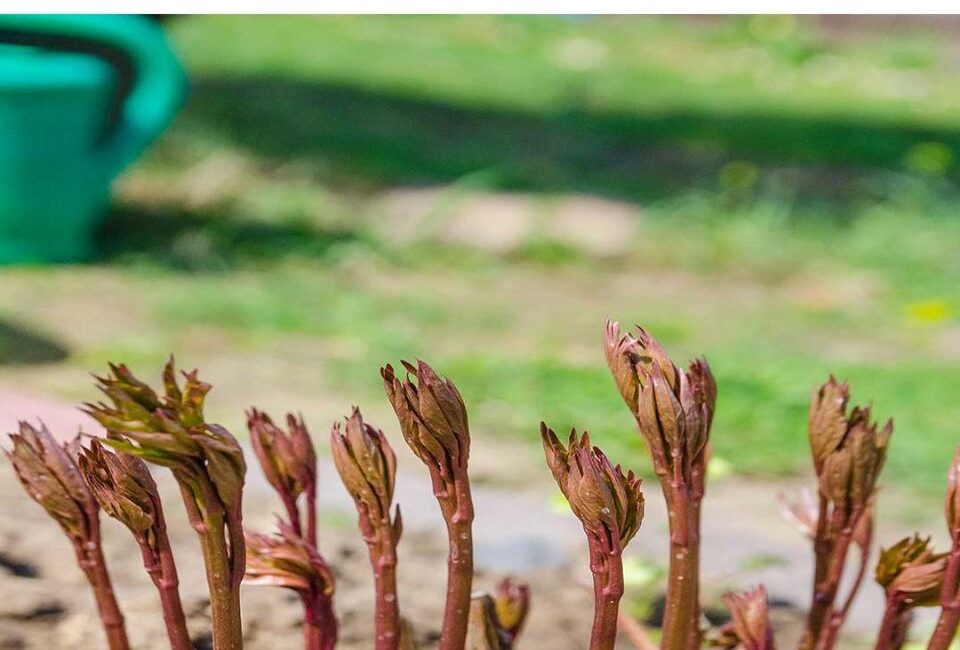Peonies are some of the most beloved and elegant flowers in gardens around the world. Known for their lush, fragrant blooms and their long-lasting perennial growth, peonies have earned their place as garden staples. However, like all plants, peonies can face challenges that hinder their growth, including poor soil conditions, nutrient deficiencies, or improper care. One of the most common issues gardeners may encounter is peonies that don’t bloom well, have yellowing or sparse foliage, or appear weak overall.
If your peony plants look like this, it may be a sign that they need some extra care, specifically in the form of fertilization. Understanding why and how to fertilize your peonies can help revive them and encourage robust, healthy growth. In this article, we’ll explore why fertilizing your peony plants is essential, how to identify when they need fertilization, and the best ways to fertilize them to achieve the best possible results.
Why Peonies Need Fertilization
Peonies, like many other garden plants, require a variety of nutrients to grow and thrive. The key to healthy peony plants is ensuring that they receive the right balance of nutrients, including nitrogen (N), phosphorus (P), potassium (K), and trace minerals. However, unlike other plants that can thrive in relatively poor soils, peonies tend to be more sensitive to nutrient imbalances, and their growth can quickly suffer if they don’t receive adequate nutrition.
Fertilization helps replenish the nutrients in the soil, improving your peony’s health, appearance, and blooming potential. Without adequate nutrients, peonies may display signs of nutrient deficiencies, leading to stunted growth, poor foliage, and weak stems. Fertilizing not only improves the overall health of the plants but also helps promote the lush, vibrant flowers for which peonies are famous.
Identifying Peonies That Need Fertilization
Before applying any fertilizers to your peonies, it’s essential to first assess whether they need additional nutrients. There are several signs that may indicate your peony plants require fertilization:
1. Yellowing Leaves (Chlorosis)
One of the most common signs that your peonies need fertilization is yellowing leaves. This condition, known as chlorosis, typically results from a nitrogen deficiency, which affects the plant’s ability to produce chlorophyll, the pigment responsible for the green color of the leaves. If the leaves of your peonies are turning yellow, particularly starting from the bottom and progressing upwards, it’s an indication that they may not have enough nitrogen.
2. Poor or Sparse Blooming
Peonies are prized for their beautiful, large blooms. If your peonies are not flowering as profusely as they should, it could be due to an imbalance of nutrients. Peonies require phosphorus to develop strong flowers and healthy roots. A lack of phosphorus can result in plants that produce fewer or smaller blooms, or in some cases, no blooms at all.
3. Stunted or Weak Growth
If your peonies are growing slower than usual or seem weak, with small, pale leaves, it might be because they’re not getting enough nutrients to support healthy development. This can be especially apparent in younger plants or those that were transplanted recently. In such cases, fertilization can help give your peonies the boost they need to grow strong and healthy.
4. Reduced Vigorous Foliage
Peonies should have lush, green foliage that supports the development of flowers. If the leaves are sparse, discolored, or struggling to grow, it’s another indication that they may need fertilizer. Nutrient deficiencies, particularly in nitrogen and potassium, can result in weak foliage that impacts the overall growth and flowering of the plant.
5. Poor Soil Conditions
If your garden soil is low in organic matter, or you’ve been growing peonies in the same spot for several years without replenishing the soil, the peonies may suffer from depleted soil nutrients. This can lead to poor overall plant health, even if there aren’t immediate visible signs like yellowing leaves or stunted growth.
How to Fertilize Your Peony Plants
Once you’ve determined that your peony plants need fertilization, it’s time to act. Fertilizing your peonies correctly is crucial to ensuring they get the proper nutrients they need. The key is to choose the right type of fertilizer, apply it at the right time, and avoid over-fertilizing, which can harm your plants.
1. Choose the Right Fertilizer
Peonies have specific nutrient needs, and choosing the right fertilizer is essential to providing the proper care. Generally, a balanced fertilizer with a ratio like 10-10-10 (10% nitrogen, 10% phosphorus, and 10% potassium) is a great all-purpose option for peonies. This type of fertilizer provides the three primary macronutrients needed for healthy plant growth.
However, for peonies, it’s often beneficial to prioritize phosphorus because it encourages strong flowering and root development. Look for a fertilizer that is higher in phosphorus, such as a 5-10-10 or 10-20-10 formulation. These fertilizers support root growth and enhance flowering, which are both crucial for vibrant, healthy peonies.
If your soil is already rich in certain nutrients, such as nitrogen or potassium, you can use a fertilizer that focuses on a specific nutrient to address a particular deficiency.
2. Fertilize in Early Spring
The best time to fertilize your peonies is in early spring, just as new growth begins to appear. This is the time when peonies are preparing to grow and bloom, and providing them with nutrients at this stage helps them establish strong roots and produce vigorous foliage. Avoid fertilizing too early, as the plants are still dormant in late winter, and fertilizing at this time can lead to nutrient waste and potential harm.
If you live in a region with a mild climate, you can fertilize in early spring as soon as the soil thaws and the peony shoots start to appear. In colder regions, you may need to wait until late March to early April, depending on your local climate.
3. Apply a Slow-Release Fertilizer
A slow-release fertilizer is ideal for peonies because it provides a steady supply of nutrients over an extended period of time. This type of fertilizer ensures that your plants get nutrients as they need them, rather than receiving all of the nutrients at once. This is particularly helpful for peonies, which require consistent nutrition to support their long growing season.
Slow-release fertilizers break down gradually, releasing nutrients over several months. This reduces the risk of over-fertilizing, which can lead to root burn, and ensures that your peonies get the proper care throughout the growing season.
4. How to Apply Fertilizer
When applying fertilizer, follow the manufacturer’s instructions carefully, as over-fertilizing can damage your peonies. You can apply fertilizer either as a top-dressing or by incorporating it into the soil.
Top Dressing:
- Apply a thin layer of fertilizer around the base of the peony plant, about 6-8 inches away from the stem. Avoid getting fertilizer directly on the plant’s stems or leaves.
- Gently work the fertilizer into the soil with a rake or your hands, but be careful not to disturb the roots too much.
- Water the soil thoroughly after applying the fertilizer to help it dissolve and soak into the soil.
Incorporating into Soil:
- If you’re planting or transplanting peonies, mix the fertilizer into the soil before planting. This helps establish a nutrient-rich environment for the peony to develop healthy roots.
- For established plants, you can dig small holes around the plant and add fertilizer directly into the soil.
5. Don’t Over-fertilize
While fertilization is essential for healthy peony growth, over-fertilizing can be harmful. Excessive fertilizer can lead to burned roots, nutrient imbalances, and reduced flowering. Always follow the recommended application rates on the fertilizer label, and be mindful of your plant’s specific needs.
6. Water After Fertilizing
After applying fertilizer, it’s crucial to water the soil thoroughly. This helps dissolve the fertilizer and ensures it’s absorbed into the soil and taken up by the plant’s roots. Watering also prevents the buildup of salts in the soil, which can be harmful to the plant if allowed to accumulate.
7. Reapply Mid-Season if Needed
In some cases, particularly if your soil is nutrient-poor or the peonies are showing signs of nutrient deficiencies later in the growing season, you may need to apply a second round of fertilizer around mid-season. However, this should be done with caution. A light application of a balanced, slow-release fertilizer should be sufficient.
Other Tips for Ensuring Healthy Peonies
Along with fertilizing, there are a few other essential tips for keeping your peonies healthy and encouraging blooming:
- Mulching: Apply a layer of mulch around the base of your peony plants to retain moisture, regulate soil temperature, and suppress weeds. Organic mulch such as compost, shredded leaves, or pine bark is ideal.
- Proper Spacing: Ensure that your peonies have adequate space for air circulation and growth. Overcrowding can reduce blooming and lead to disease.
- Staking: Some peony varieties can become top-heavy as they bloom. Use stakes or supports to prevent stems from breaking under the weight of the flowers.
Conclusion
Fertilizing your peonies is essential for ensuring they have the nutrients they need to thrive and produce their signature beautiful blooms. By identifying signs of nutrient deficiencies, choosing the right fertilizer, and applying it correctly at the appropriate times, you can significantly improve the health and flowering



